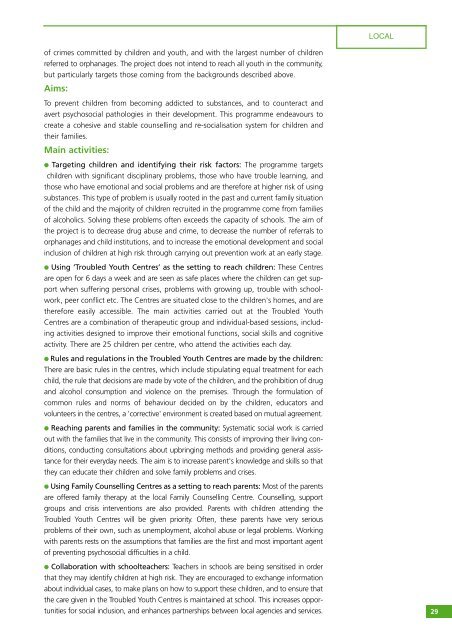PDF (Lessons learned in drug abuse prevention: a global review)
PDF (Lessons learned in drug abuse prevention: a global review)
PDF (Lessons learned in drug abuse prevention: a global review)
Create successful ePaper yourself
Turn your PDF publications into a flip-book with our unique Google optimized e-Paper software.
of crimes committed by children and youth, and with the largest number of children<br />
referred to orphanages. The project does not <strong>in</strong>tend to reach all youth <strong>in</strong> the community,<br />
but particularly targets those com<strong>in</strong>g from the backgrounds described above.<br />
Aims:<br />
To prevent children from becom<strong>in</strong>g addicted to substances, and to counteract and<br />
avert psychosocial pathologies <strong>in</strong> their development. This programme endeavours to<br />
create a cohesive and stable counsell<strong>in</strong>g and re-socialisation system for children and<br />
their families.<br />
Ma<strong>in</strong> activities:<br />
● Target<strong>in</strong>g children and identify<strong>in</strong>g their risk factors: The programme targets<br />
children with significant discipl<strong>in</strong>ary problems, those who have trouble learn<strong>in</strong>g, and<br />
those who have emotional and social problems and are therefore at higher risk of us<strong>in</strong>g<br />
substances. This type of problem is usually rooted <strong>in</strong> the past and current family situation<br />
of the child and the majority of children recruited <strong>in</strong> the programme come from families<br />
of alcoholics. Solv<strong>in</strong>g these problems often exceeds the capacity of schools. The aim of<br />
the project is to decrease <strong>drug</strong> <strong>abuse</strong> and crime, to decrease the number of referrals to<br />
orphanages and child <strong>in</strong>stitutions, and to <strong>in</strong>crease the emotional development and social<br />
<strong>in</strong>clusion of children at high risk through carry<strong>in</strong>g out <strong>prevention</strong> work at an early stage.<br />
● Us<strong>in</strong>g ‘Troubled Youth Centres’ as the sett<strong>in</strong>g to reach children: These Centres<br />
are open for 6 days a week and are seen as safe places where the children can get support<br />
when suffer<strong>in</strong>g personal crises, problems with grow<strong>in</strong>g up, trouble with schoolwork,<br />
peer conflict etc. The Centres are situated close to the children's homes, and are<br />
therefore easily accessible. The ma<strong>in</strong> activities carried out at the Troubled Youth<br />
Centres are a comb<strong>in</strong>ation of therapeutic group and <strong>in</strong>dividual-based sessions, <strong>in</strong>clud<strong>in</strong>g<br />
activities designed to improve their emotional functions, social skills and cognitive<br />
activity. There are 25 children per centre, who attend the activities each day.<br />
● Rules and regulations <strong>in</strong> the Troubled Youth Centres are made by the children:<br />
There are basic rules <strong>in</strong> the centres, which <strong>in</strong>clude stipulat<strong>in</strong>g equal treatment for each<br />
child, the rule that decisions are made by vote of the children, and the prohibition of <strong>drug</strong><br />
and alcohol consumption and violence on the premises. Through the formulation of<br />
common rules and norms of behaviour decided on by the children, educators and<br />
volunteers <strong>in</strong> the centres, a 'corrective' environment is created based on mutual agreement.<br />
● Reach<strong>in</strong>g parents and families <strong>in</strong> the community: Systematic social work is carried<br />
out with the families that live <strong>in</strong> the community. This consists of improv<strong>in</strong>g their liv<strong>in</strong>g conditions,<br />
conduct<strong>in</strong>g consultations about upbr<strong>in</strong>g<strong>in</strong>g methods and provid<strong>in</strong>g general assistance<br />
for their everyday needs. The aim is to <strong>in</strong>crease parent's knowledge and skills so that<br />
they can educate their children and solve family problems and crises.<br />
● Us<strong>in</strong>g Family Counsell<strong>in</strong>g Centres as a sett<strong>in</strong>g to reach parents: Most of the parents<br />
are offered family therapy at the local Family Counsell<strong>in</strong>g Centre. Counsell<strong>in</strong>g, support<br />
groups and crisis <strong>in</strong>terventions are also provided. Parents with children attend<strong>in</strong>g the<br />
Troubled Youth Centres will be given priority. Often, these parents have very serious<br />
problems of their own, such as unemployment, alcohol <strong>abuse</strong> or legal problems. Work<strong>in</strong>g<br />
with parents rests on the assumptions that families are the first and most important agent<br />
of prevent<strong>in</strong>g psychosocial difficulties <strong>in</strong> a child.<br />
LOCAL<br />
● Collaboration with schoolteachers: Teachers <strong>in</strong> schools are be<strong>in</strong>g sensitised <strong>in</strong> order<br />
that they may identify children at high risk. They are encouraged to exchange <strong>in</strong>formation<br />
about <strong>in</strong>dividual cases, to make plans on how to support these children, and to ensure that<br />
the care given <strong>in</strong> the Troubled Youth Centres is ma<strong>in</strong>ta<strong>in</strong>ed at school. This <strong>in</strong>creases opportunities<br />
for social <strong>in</strong>clusion, and enhances partnerships between local agencies and services. 29
















